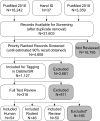Environmental Chemicals and Autism: A Scoping Review of the Human and Animal Research
- PMID: 30942615
- PMCID: PMC6785231
- DOI: 10.1289/EHP4386
Environmental Chemicals and Autism: A Scoping Review of the Human and Animal Research
Abstract
Background: Estimates of autism prevalence have increased dramatically over the past two decades. Evidence suggests environmental factors may contribute to the etiology of the disorder.
Objectives: This scoping review aimed to identify and categorize primary research and reviews on the association between prenatal and early postnatal exposure to environmental chemicals and the development of autism in epidemiological studies and rodent models of autism.
Methods: PubMed was searched through 8 February 2018. Included studies assessed exposure to environmental chemicals prior to 2 months of age in humans or 14 d in rodents. Rodent studies were considered relevant if they included at least one measurement of reciprocal social communicative behavior or repetitive and stereotyped behavior. Study details are presented in interactive displays using Tableau Public.
Results: The search returned 21,603 unique studies, of which 54 epidemiological studies, 46 experimental rodent studies, and 50 reviews were deemed relevant, covering 152 chemical exposures. The most frequently studied exposures in humans were particulate matter ([Formula: see text]), mercury ([Formula: see text]), nonspecific air pollution ([Formula: see text]), and lead ([Formula: see text]). In rodent studies, the most frequently studied exposures were chlorpyrifos ([Formula: see text]), mercury ([Formula: see text]), and lead ([Formula: see text]).
Discussion: Although research is growing rapidly, wide variability exists in study design and conduct, exposures investigated, and outcomes assessed. Conclusions focus on recommendations to guide development of best practices in epidemiology and toxicology, including greater harmonization across these fields of research to more quickly and efficiently identify chemicals of concern. In particular, we recommend chlorpyrifos, lead, and polychlorinated biphenyls (PCBs) be systematically reviewed in order to assess their relationship with the development of autism. There is a pressing need to move forward quickly and efficiently to understand environmental influences on autism in order to answer current regulatory questions and inform treatment and prevention efforts. https://doi.org/10.1289/EHP4386.
Figures





Comment in
-
Getting the Lay of the Land: Human and Animal Evidence on Environmental Chemicals and Autism.Environ Health Perspect. 2019 Sep;127(9):94002. doi: 10.1289/EHP5674. Epub 2019 Sep 3. Environ Health Perspect. 2019. PMID: 31478758 Free PMC article. No abstract available.
References
-
- American Psychiatric Association. 1994. Diagnostic and Statistical Manual of Mental Disorders. 4th ed Arlington, VA:American Psychiatric Publishing, Inc.
-
- American Psychiatric Association. 2013. Diagnostic and Statistical Manual of Mental Disorders. 5th ed Washington, DC:American Psychiatric Association.
-
- Arcury TA, Grzywacz JG, Isom S, Whalley LE, Vallejos QM, Chen H, et al. . 2009. Seasonal variation in the measurement of urinary pesticide metabolites among Latino farmworkers in eastern North Carolina. Int J Occup Environ Health 15(4):339–350, PMID: 19886344, 10.1179/oeh.2009.15.4.339. - DOI - PMC - PubMed
-
- Autism and Developmental Disabilities Monitoring Network Surveillance. 2007. Prevalence of autism spectrum disorders–autism and developmental disabilities monitoring network, 14 sites, United States, 2002. MMWR Surveill Summ 56(1):12–28, PMID: 17287715 https://www.cdc.gov/mmwr/preview/mmwrhtml/ss5601a2.htm. - PubMed
-
- Baio J, Wiggins L, Christensen DL, Maenner MJ, Daniels J, Warren Z, et al. . 2018. Prevalence of autism spectrum disorder among children aged 8 years - autism and developmental disabilities monitoring network, 11 sites, United States, 2014. MMWR Surveill Summ 67(6):1–23, PMID: 29701730, 10.15585/mmwr.ss6706a1. - DOI - PMC - PubMed
Publication types
MeSH terms
Substances
LinkOut - more resources
Full Text Sources
Miscellaneous

